Bearded Dragons are friendly and popular pet lizards that originate from Australia.
Their popularity is due to them being very easy to care for. However, setting up a great bearded dragon habitat can be difficult for beginners.
First time keepers can make enclosure set-up mistakes such as using the wrong lighting and substrate that can impact the health and wellbeing of their pet.
When provided with a good habitat and the correct size tank, bearded dragons can live for 14 years.
If you want to know how to build the perfect bearded dragon enclosure so that your Beardie can live to its fullest then keep reading!
Bearded Dragon Habitat
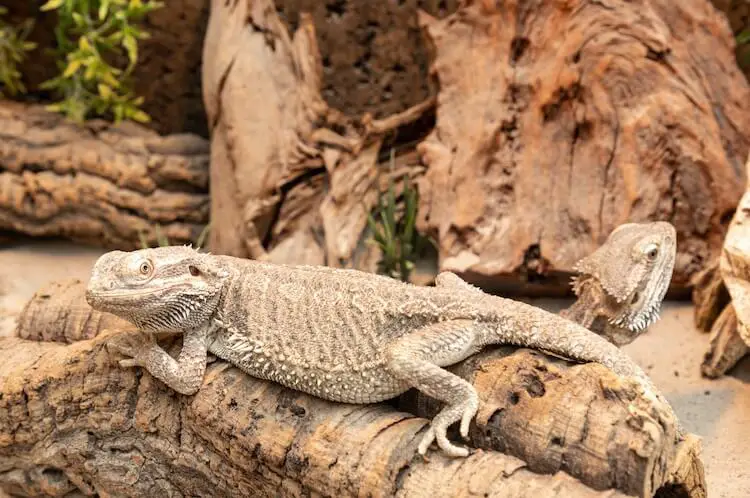
Every type of Bearded Dragon species is native to Australia.
There are eight subspecies of Beardies who all live on separate parts of the island. Where they live in Australia determines their habitat. This can be anything from deserts to subtropical woodlands.
This guide will focus on the Pagona vitticeps species as it is the most common lizard to be kept by beginners:
| Species | Location |
|---|---|
| Pogona barbata | Eastern Australia |
| Pogona henrylawsoni | Western and Central Australia |
| Pogona microlepidota | Northern Australia |
| Pogona minor minor | Western and Central Australia |
| Pogona minor minima | Houtman Abrolhos Islands |
| Pogona minor mitchelli | Northwestern Australia |
| Pogona nullarbor | Southern Australia |
| Pogona vitticeps | Central Australia |
The bearded dragon vitticeps species lives in Central Australia so its habitat is all desert.
In the wild they have over 12 hours of intense sunlight a day with very few lakes or ponds nearby. This creates an environment that is hot and dry (i.e. low humidity).
There are some scrubs, small trees, and rocky areas in Central Australia. This means this species is only semi-arboreal and is not an extreme climber.
Because of the environment they live in Bearded Dragons have many unique adaptations:
- They have a third eye to detect shadows above them.
- Their head is inverted to allow water droplets to slide from the top of their head to their mouth.
- They have spike-shaped scales as a defense mechanism from many desert predators.
Their habitat is the reason why they need UVA and UVB rays for everyday metabolic function. The dry environment is also the reason why they stay hydrated by eating insects and vegetation over drinking.
Because the desert is very hot Bearded Dragons squeeze into small rock crevices to cool down. They also climb plants for higher basking spots to evade predators.
In captivity you must provide climbing and hiding enrichment and replicate the intense sun and low humidity.
First time keepers often buy enclosures that are too small, have coiled UVB lights, use dangerous sand substrates or forget to provide climbing and hiding enrichment.
Below is the perfect bearded dragon habitat.
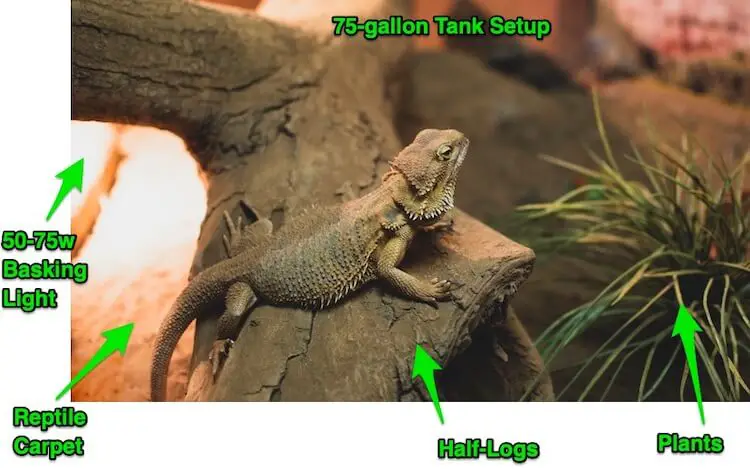
Best Bearded Dragon Setup
Beardies in captivity should live in an environment that mimics their real desert habitat. Their enclosure should be large enough and have the correct lighting, temperature and humidity. It should also have climbing and hiding enrichment:
| Attribute | Requirement |
|---|---|
| Tank | 75-gallons and wooden or plastic |
| Temperature | 95-100℉ (high) and 75℉ (low) |
| Humidity | Between 30% to 40% |
| Lighting | UVB tube light and 75w UVA basking light |
| Substrate | Reptile carpet |
| Supplies & Decoration | Branches, Hammocks, Half-Logs, Plants, Hides and Bath Dish |
Bearded dragons are naturally solitary and very territorial of their habitat.
They should not be housed with other beardies – not even for mating. Females store sperm so they do not have to near males more than once per breeding season
This species will at some point fight over food, hides or their territory. They have been known to cannibalize baby beardies.
Types of Bearded Dragon Enclosures
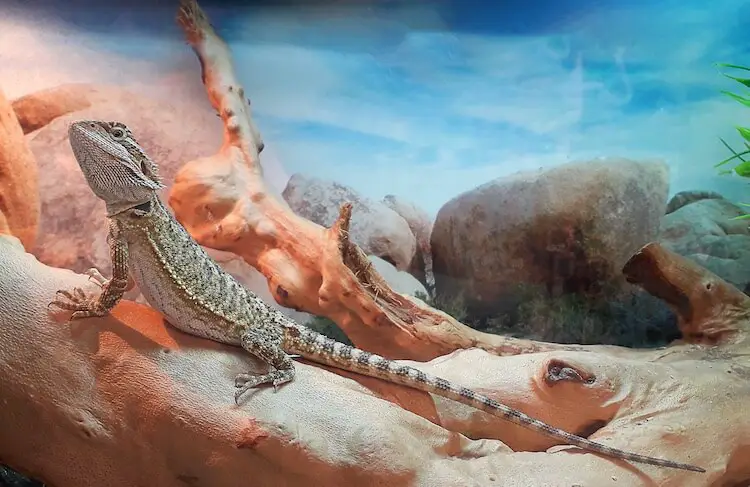
There are three different materials to choose from for a Bearded Dragon tank:
- Glass (cheapest)
- PVC plastic
- Wooden (best)
Plastic and wooden vivariums are usually enclosed and have a glass front panel. They are both the best enclosure types because they are very effective at holding heat in.
However, glass tanks are popular with beginners because of their price and availability. They also provide a more complete view of your reptile. If you decide to purchase a glass vivarium make sure not to place it by any drafty window, radiator or fireplace.
Place their enclosure in the corner of a room to help reduce heat loss.
After purchasing a vivarium you will also need to choose a lid:
- Standard
- Split-top
- Single or Double hinged lids
- Front panel sliding/lifting doors
The best lid type is a split top where one half is able to slide off and the back half stays stationary. The back half provides enough room for a lamp to stay undisturbed (you can easily burn yourself by touching them accidentally).
Make sure that the lid doors close properly to avoid any injury to your lizard.
What Size Tank Should I Get For A Bearded Dragon?
A Bearded Dragon enclosure must be long, wide and at-least 75-gallons in size. The exact tank size will depend on the age and size of your beardie. You can use the handy chart below to help you find a vivarium according to your beardie’s age:
| Tank Size (gallons) | Bearded Dragon Age (months) |
|---|---|
| 20 | 1 |
| 30 | 2 |
| 40 | 3-4 |
| 50 | 5-6 |
| 65 | 7-8 |
| 75 | 9-12 |
| 120 | 12+ |
The emphasis for a Bearded Dragon’s tank should be on floor space. They will most likely spend the majority of their time there hunting, climbing, soaking, and sleeping.
Bearded dragons are large reptiles so they need enough space to walk and climb.
Because reptiles are ectotherms they rely on their environment to regulate their body temperature.
They require a range of temperatures from 100℉ to 75℉ within their habitat and it will need to be large enough to create a real thermogradient (i.e. warmer and cooler areas).
Bearded Dragon Lighting
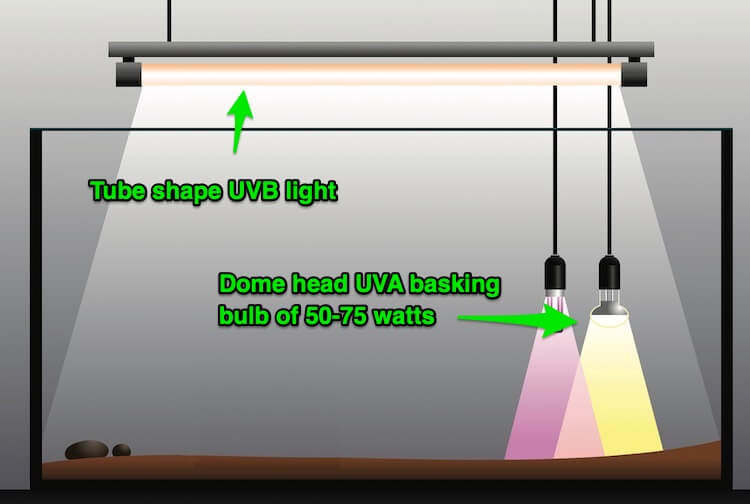
Your vivarium will need an overhead UVA basking bulb of 50-75 watts. This will mimic the intense sun’s rays.
It is best to use a dome-head lamp that can sit directly on top of the mesh screen lid. Alternatively you can use a hanging lamp fixture. It should be replaced two to three times annually. The temperature of their highest basking spot to be 95-100℉.
Then they will also need a UVB tube light. You should use a tube shape UVB light not coil shaped.
Fit the UVB light using a tube light hood that secures underneath the mesh lid. You do not want the light sitting on top of the mesh because it blocks out 40% of the rays.
Many coil lights are ineffective in delivering the appropriate amounts of UVB. Like the UVA bulb it will need to be replaced every six months as its UVB production wears out.
Timers are especially valuable for lighting.
Bearded Dragons need 12-hour day and night cycles. Use a light timer for at least two plugs and program it for 12 hours daily from 7AM to 7PM.
Feed your bearded dragon at the beginning of the day to give them enough time to digest their food before lights out.
Infrared night heat lights are not recommended as they disturb your beardie’s circadian rhythm.
Enclosure Heating
Bearded Dragons rely on external heat sources to regulate their body temperature. They require a temperature gradient that moves from an intensely hot 100℉ to a cool 75℉.
A bearded dragon’s behavior will indicate if their body temperature is too high or too low:
- When they feel hot they hold their mouth open and are brightly colored.
- When they are cold they will turn their darkest possible shade to absorb any heat source available.
Their habitat needs to have a range of temperatures to keep them healthy so their tank should have both a cool side and a hot side.
The hot side should include the basking lamp.
Your Bearded Dragon will need different decor and landscaping to get as close as they need to the basking lamp. The highest height of basking should be six inches from the top of the tank. You can use strong branches or reptile hammocks to achieve this.
The cooler side of their habitat should be far away from the basking lamp and have hides and shading plants.
To measure the habitat’s temperature you should use a digital thermometer and probe. Stick-on thermostats are not reliable.
If temperatures drop below 65℉ at nighttime then use a ceramic heater.
Enclosure Humidity
Bearded Dragons require low humidity levels because of their native desert habitat. The ideal humidity level ranges from 30-40%.
If humidity is too high then your dragon will be susceptible to developing medical issues and respiratory infections. When humidity levels are lower than 30% your lizard will dehydrate.
You can tell if your Bearded Dragon is dehydrated as they will have extremely wrinkled skin. Beardies will choose to soak when they are shedding or dehydrated.
The best way to maintain humidity is to include a soaking water dish in their tank and let it evaporate.
A water dish can be a plastic container (without toxic dyes/paint) and should be large enough to fit their body. The best size is 2″ deep, 7″ wide and 10″ long. Do not fill the dish any deeper than their ear level – this will prevent any chance of drowning.
They are unlikely to drink directly from the water dish as most of their water intake comes from the vegetation and insects they eat.
Bearded Dragon Substrate
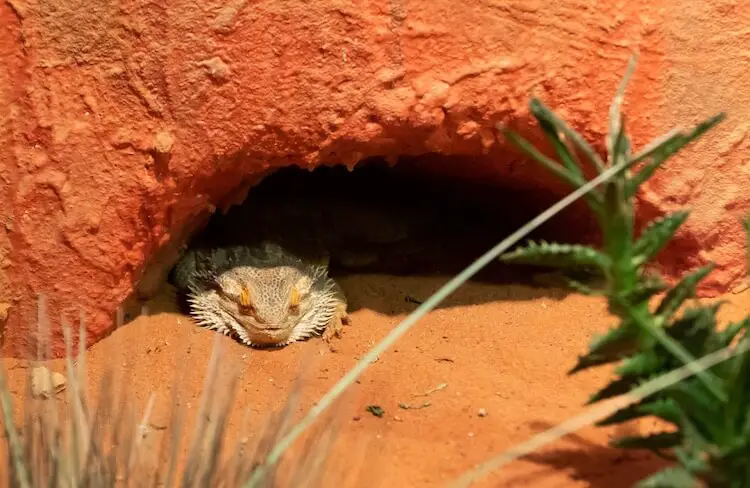
Sand is a major part of their habitat in the wild. However desert sand is not like the commercial sand sold for reptiles. Sand in their native habitat is rich in calcium and other minerals and they will ingest small quantities that provide them with just the right amount of these precious nutrients. Commercially-available sand is often poor in calcium, so the instinct for a calcium-deficient dragon is to keep eating it and get a blocked intestine, a condition called impaction.
In the wild Bearded Dragons easily hunt insects without ingesting sand particles. The issue with impaction seems to be caused by calcium deficiency. The idea that dragons eat it by mistake seems to apply only to young and inexperienced dragons.
These sand particles are tiny but can cause huge medical problems for your bearded dragon’s intestines and cause impaction. Impaction is a very common health issue for reptiles and is fatal.
The best substrate is reptile carpet made of felt, fake grass or hardened desert ground. Sand can be safely used with adult beardies, only if sufficient sources of calcium are provided: the most common way is through supplements in their diet, but some people like to put a sepia bone (or shed some small pieces of it) in the enclosure, since these would be calcium rich and readily available. The benefit of using sand is replicating conditions similar to their natural habitat and allowing them to dig: one of their favorite activities.
You can also use 12×12″ ceramic tiles to cover 30% of the tank to help keep your bearded dragon’s claws short whilst providing a nice area for them to cool down.
Supplies, Decor, and Landscaping
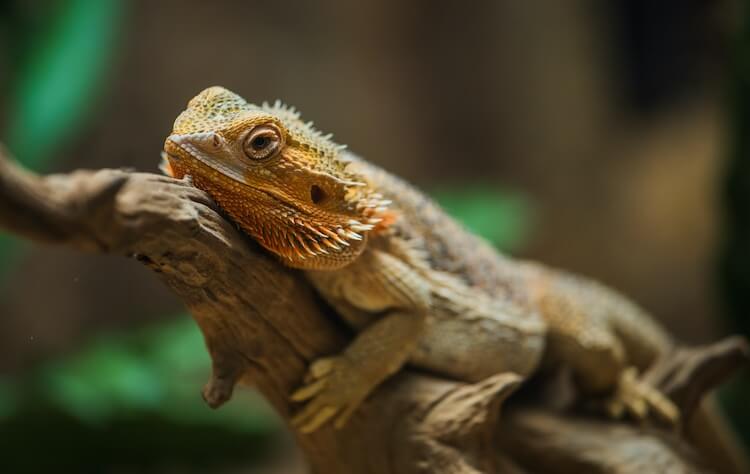
You should aim to build a habitat that has climbing and hiding enrichment for your pet with lots of logs, hides and caves. In the hot side of the tank you should add:
- Reptile hammock(s).
- Strong branches.
- Rock decor.
If you find rocks and branches from the wild then soak them in boiling water to remove any potential bacteria or parasites.
For the cool side add half-logs, cave hides and vine or bush-like plants that are pesticide-free.
Making the best bearded dragon habitat requires you to think through the eyes of your bearded dragon:
- What will provide them with the most engaging landscape?
- How can you make their tank as healthy and appealing as possible?
Bearded dragon habitats are commonly desert-themed, with fake cacti, a desert background and sand-like reptile carpet.
Summary
Bearded dragons are some of the most fun reptiles to keep and have very simple husbandry requirements after setting up their enclosure.
A perfect Bearded Dragon habitat should have:
- 75-gallon wooden or plastic tank.
- 50 watt dome-head UVA basking bulb.
- Tube shape UVB light secured underneath the mesh lid.
- Felt reptile carpet.
- Two dishes for food and water.
- Lots of plants, decor, hides and caves.
When purchasing their supplies remember not every product is 100% guaranteed to be reptile safe. The pet reptile industry is not regulated so do your research, take caution and read lots of reviews.
If you follow all of the steps in this article you will be sure to have a healthy beardie.
After you have finished building their habitat don’t forget to take them out for daily handling!
Have you ever owned a Bearded Dragon before? How did you setup their enclosure? Let us know in the comments below.

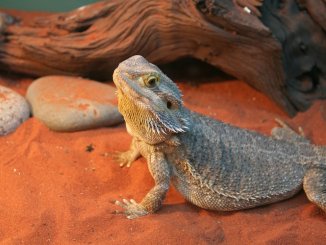
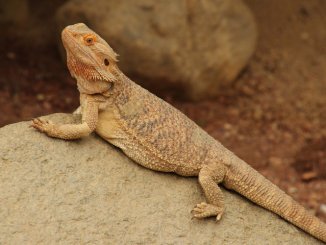
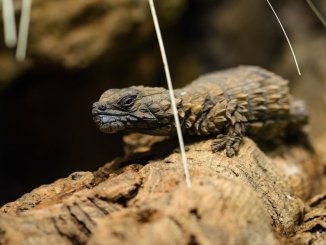
My beardy has run of the room. We have floor to sealing windows and have lots of branches so he can climb alot. He basks in the sun in the window. He climbs into a basket when he wants to sleep. We feed him once a day and fruit every other day with calcium powder.
My beardie has slate. Nails and even teeth can get caught in the fibres of reptile carpet.
My beardy has long nails so I want something to help keep them shorter. What kind of slate do you use? And where do you get it?
Terra cotta can also be used, you can use rocks you find around outside and wood. Just make sure to bake the wood before to kill parasites:)
Can you please help me. I need to know a good length and width of tile to use. My friend and I got the same enclosure which is made by Dubia and inside length is close to 47 and width is 22.5. We are not wanting to add or cut alot of pieces of the tile. So we would like to have any suggestions. Thank you
What do you do about lighting/ heat lamp?
You need your a UVB light end it needs to be 100 degrees f
And at night and needs to be 70°F
What do you feed your beardy everyday? Mine is old enough to only require bugs twice a week.
Turnip greens, mustard greens, arugula, collard greens. No Kale. Red, yellow or orange bell peppers, yellow squash, acorn squash and zucchini. Fruit is only 1 time a week. Raspberries, blueberries and grapes they love. If you need more suggestions let me know and I can get a good list. Hope this helps.
I inherited a Berdie when my roommate joined the military. He had two UVA lights (one on each side) a basking light on one side and a heat lamp on the other set at 80. One UVA went out. Do I need light on both sides all day? Everything but the heat is in a timer. The heat is set at 80 with a thermometer.
Basking lamp and heat lamp are the same. It needs to be at least 100w.If that tank has 2 it must be incredibly hot in there. You need …
1. Basking/heat lamp 100w bulb
2. 1 UVB place in the center of the tank.
3. Incandescent lamp on cooling side.
You have to have a hot side and cool side for them. No sand, no water bowl. Hot side should be between 100 and 104 degrees and cool side should be around 80. Humidity needs to be as low as possible. Ideal is 30 to 40. Hope this helps.
Articles like this are detrimental to the keeping of these animals you sprinkle small amounts of fact in with heresay and personal opinion. It is personal preference to use a particular substrate however sand does not cause impaction by itself this requires poor husbandry as well and other substrates remove the ability to burrow which is natural behavior. In the wild, dragons live on substrate that is composed of 95.9% fine sand, 2.3% clay,
1.5% slit, and 0.3% gravel. This is not hard packed as can be seen from the composition and sourced from an article by a doctor of veterinary medicine specializing in bearded dragons.
Thank you for pointing this out. In a way you are right: sand in and on itself is not the problem, and is an enjoyable substrate for Bearded Dragons.
However, adult Dragons will instinctively eat it because in their natural habitat it is a source of calcium. Now, commercially available options often lack this characteristic and, if the dragon doesn’t intake enough calcium or has insufficient UVB exposure, it may cause him to keep eating it.
In other words, the best impaction prevention is giving them sufficient calcium, and often supplements do not quite get there.
For young Bearded Dragons however, commercial sand can be an issue, reason why they should be kept on another substrate.
These are the reasons why, generally speaking, we have given a different ‘best option’ for substrate. But we are updating our text to be more specific about the issue so… Thank you! a
Hi I am really wanting to let my handsome man have a natural habitat is there a way to contact u
Does anyone kno the best place 4 the thermostat probe cuz I hav a large vivexotic terrestrial vivarium and the mesh for the lamp 2 sit on is near enough in the middle so I can’t hav it on the wall and if I put it on the floor he comes and sits on it making the temp skyrocket any help please
You might want to consider switching up your tank enclosure setup, or simply leave it on the floor, but in a gap somewhere between a rock and something else, so as to make it less likely to be touched.
I would look on Amazon and get the 2 pack of the Govee Hydrometer Thermometer. Put one on hot side right by whatever you use for basking and the other goes on the cool side usually in the center of the cool side wall. Use command strips to hang. Also, you can download the app and have it on your phone to check. Humidity is super important.